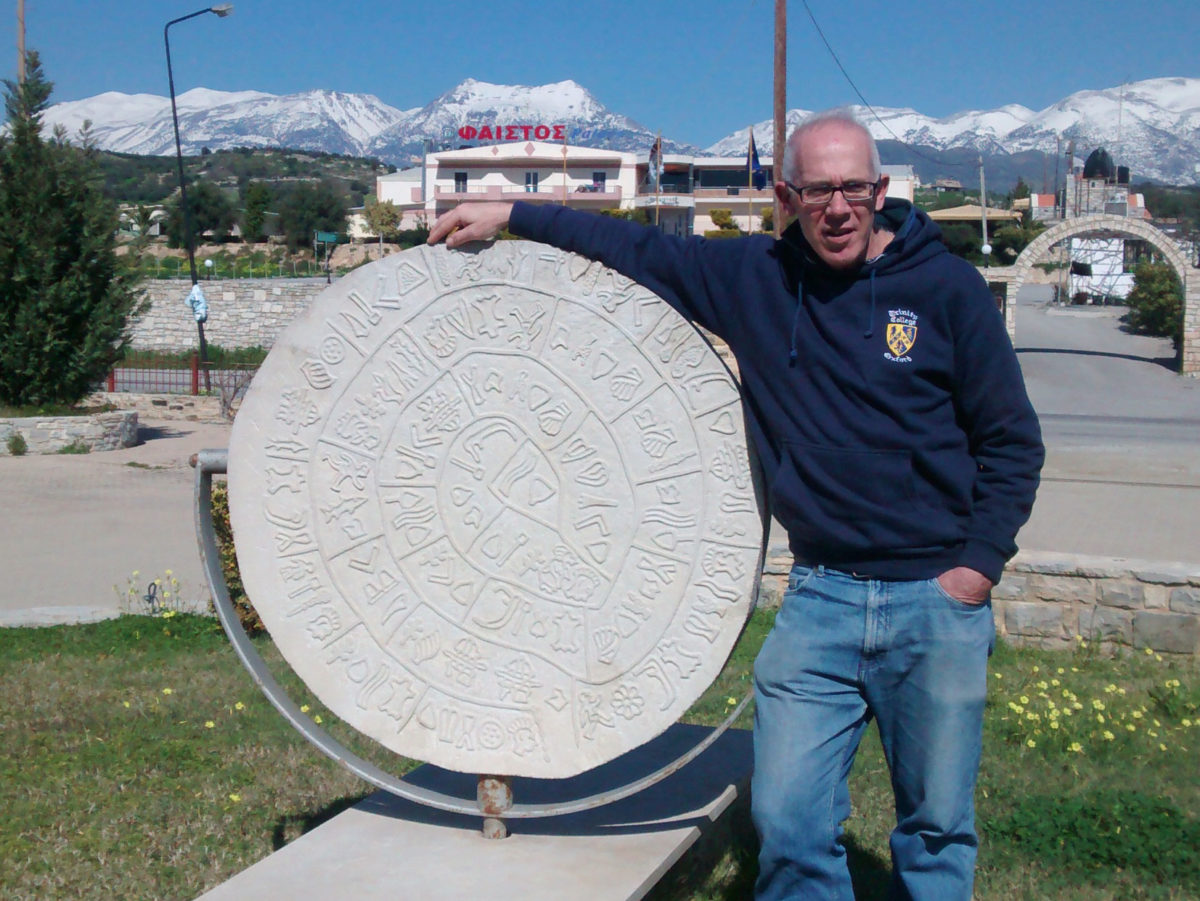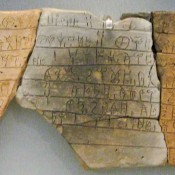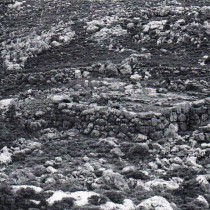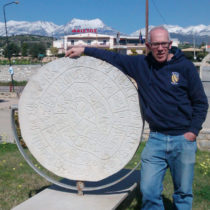The Phaistos Disk that probably dates to the 17th c. BC, gradually reveals its secrets. Linguist Dr Gareth Owens who has lived in Crete for the past 30 years (25 of which he has worked at the Technological Educational Institute (TEI) of Crete and for the past 10 as a coordinator of the Erasmus+ programme), has devoted his research time in deciphering the disk. In fact, in collaboration with Oxford phonetics professor John Coleman, he has progressed in the “reading” of 99% of the disk.
“We read the Phaistos Disk with the phonetic values of Linear B and with the help of comparative linguistics , i.e. by comparing Linear B with other related languages from the Indo- European family. Reading something, however, does not mean understanding it”, says Dr Owens to the AMNA, on the occasion of the lecture entitled “The Voice of the Phaistos Disk” he will give at the National Hellenic Research Foundation (48, V. Konstantinou Ave, Athens, www.ekt.gr) today, Wednesday, February 7, at 17.30. He adds that “The Phaistos Disk is written in Minoan script which records the Minoan language. It is the best example of ‘Cretan hieroglyphics’, always within quotation marks, because it is not the same writing system as ancient Egypt. The name is wrong. The Phaistos Disk is also a syllabic script as is the Minoan Linear A”. At the same time, he points out that the phonetic syllables on the disc have been recorded on a sound track “because I want people to listen to them. Minoan is not a dead language. Knossos, Phaistos, Crete are Minoan words, like so many others still used today”, he says.
How far, though, has the interpretation of the disk progressed, whose meaning remains an unsolved mystery? Or perhaps not such an unsolved one; “After 10 years of research, I believe over 50% of the Phaistos Disk has been deciphered; a percentage I had set as a ‘target’. In other words, I had told myself that I would present my work when I could offer a trial interpretation of more than half the words on the disk. And that is a new element of the research”, notes Dr Owens who is not afraid of revising his theories.
“When I give lectures, I try to improve on them. Earlier on I thought the disk referred to the pregnant mother. Now I believe It speaks about the pregnant goddess; a change which may appear small, but as an improvement it is big”, he says to the AMNA, and further explains: “To begin with, I had got stuck on side a of the disk, where the word I-QE-KU-RJA is repeated three times and I thought this was a keyword in its interpretation. It is the word for the pregnant goddess, as I believe. Now on side b there is a sentence that refers to this goddess who is well known from ancient Crete,” he points out to the AMNA, laconically adding so as not to give his lecture away, that “there are several words on the disk related to religion and I believe that they show us which goddess we are talking about”.
But how did everything begin? “10 years ago with my colleague John Coleman in London, we agreed that we can read the Phaistos Disk. In fact, we agreed to use the publicity caused by an American’s allegations of its being a fake, to start a scientific dialogue”, he says, adding that “With the work done by Michael Ventris, who deciphered Linear B and found that it was a Greek (Mycenaean) language five centuries before Homer, we can read the Minoan Linear A, the so called Minoan ‘Cretan Hieroglyphics’, as well as the Phaistos Disk. Because in my opinion all the above are a Minoan script that records the Minoan language,” he explains to the AMNA.
And how are they related? Dr Owen continues: “Linear A , used in the palaces for matters of administration, the so called ‘Cretan Hieroglyphics’ and the Phaistos Disk are three versions of the same Minoan script. The only thing that changes are the fonts, if I can call it that. The Phaistos Disk is not something completely alien; from another planet. And that, I believe, is the mistake made for over a century. The world saw something it could not understand. So one day after my doctorate that took me 10 years and after my book that took 4, I asked myself: Why do we have a single methodology for Mycenaean Linear B, Minoan Linear A, and “Cretan Hieroglyphics”, whereas, when talking about the Phaistos Disk we go… mad? It’s not right. We should have a single methodology for Minoan script. And this is what I have used. On my website www.teicrete.gr/daidalika in Signary, Coleman and I have created a table with all the signs of the Phaistos Disk and their corresponding Minoan and Mycenaean signs. This is our way of checking”, and he concludes by saying : “The Phaistos Disk is Minoan script in the form of a text, but it is also a work of art. That is its fascination. To me the Phaistos Disk is the bible of Minoan Crete”.





